Why Japanese People Live So Long- A comic essay
/You can get more comics like this as soon as they post by subscribing to my newsletter, A New Creative Life, by CLICKING RIGHT HERE.
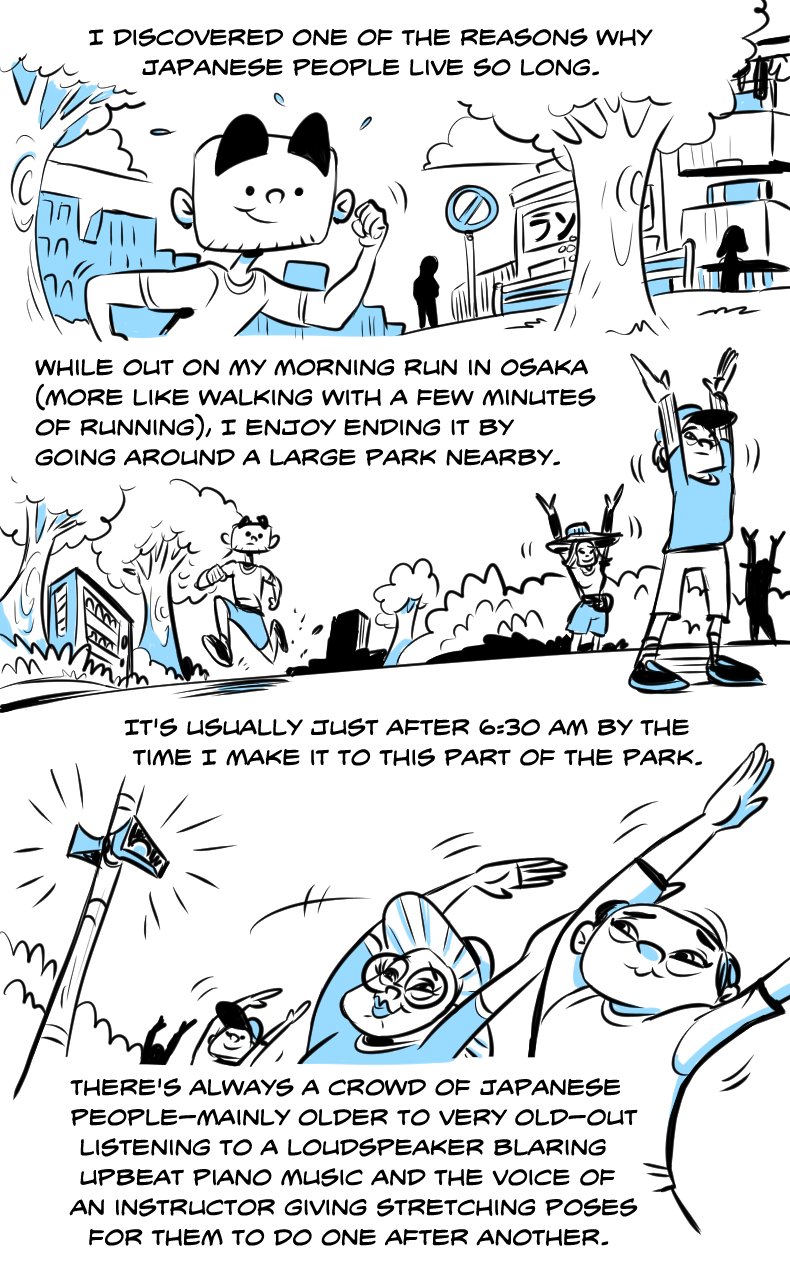

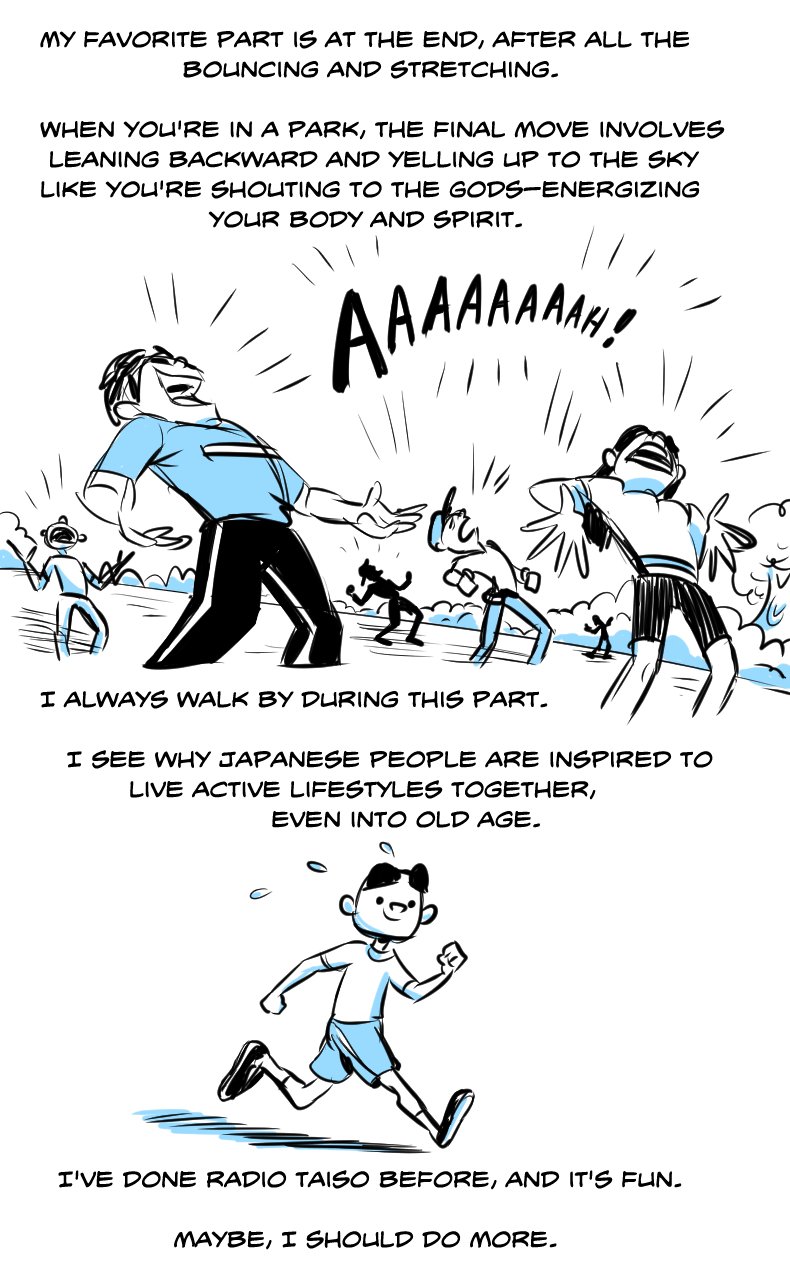
You can get more comics like this as soon as they post by subscribing to my newsletter, A New Creative Life, by CLICKING RIGHT HERE.
Cartooning workshops I teach are a lot of fun and ordinarily predictable.
They work how you’d expect. You advertise to a particular age group of kids, that age group shows up at the school or library, and we draw comics together. Everyone learns something new and leaves getting what they signed up for.
It didn’t go exactly this way at the one I taught last week.
I met an interesting man who showed me that sometimes classes might be the opposite of what you're accustomed to, so always be ready for anything.
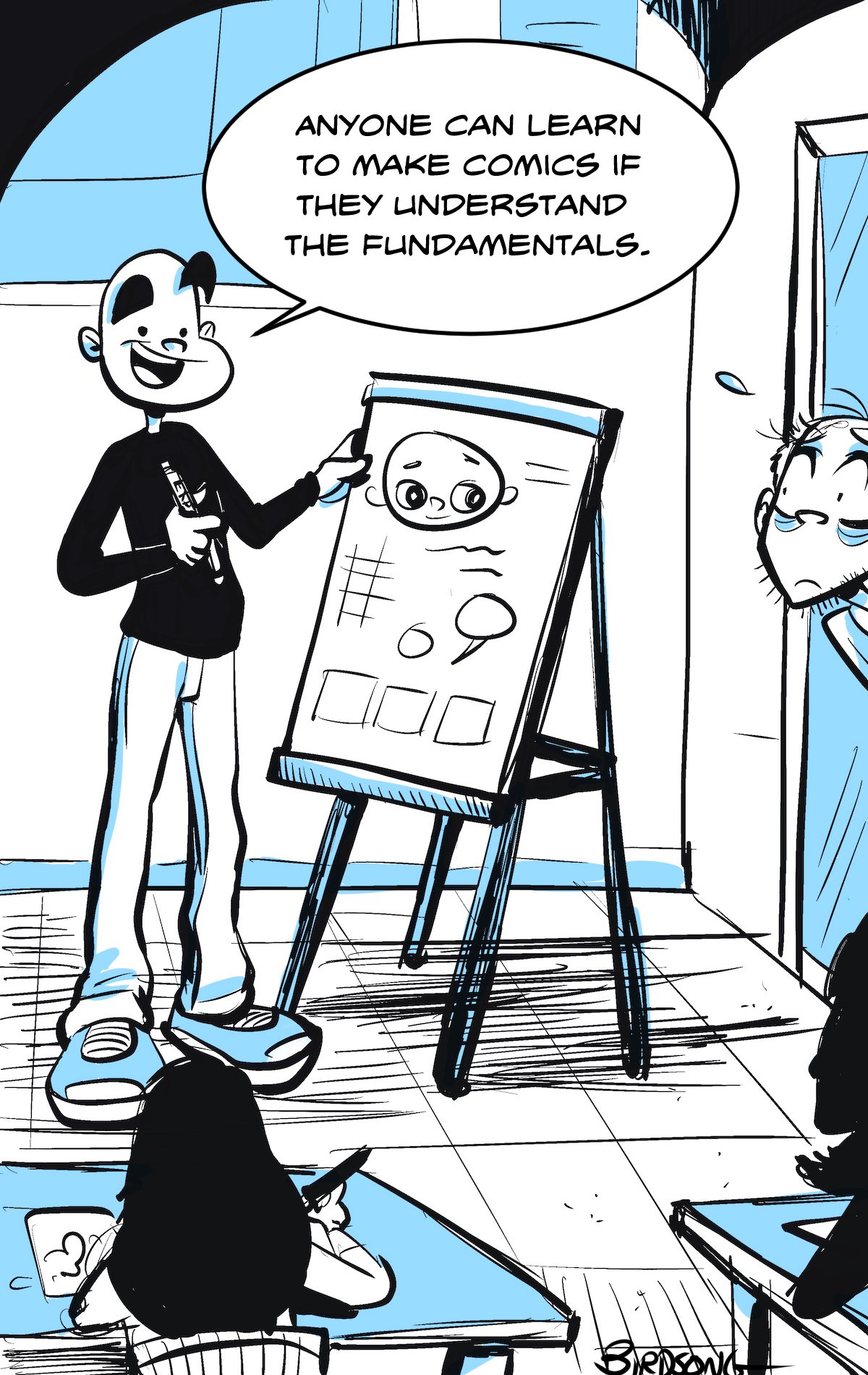
When I say the class was opposite, I'm talking about Bizarro world opposite.
This particular one was advertised for teenagers—which worried me because I’ve never done one for that age group, and I was afraid they wouldn’t show up—they’re not who I would think would be interested in group cartooning lessons.
Cartooning classes are always packed when I hold them for elementary and middle school age. The younger kids love them! Teenage artists tend to hide away in their rooms or with their close friends.
I remember my mother signing me up for a comic book art class in high school, and I couldn’t wait to go. Classes about making comics were impossible to find back then, so I was definitely going. Of course, I was the only teenager there; all the others were elementary school students, but I had a blast.
Unfortunately, my suspicions about how many teens would show up for my class this time were correct.
I was surprised because I can never get any students I usually teach art to at my school to attend these library events. The first person to walk in was one of my sixth graders, let’s call her Amy, who lives in the area and saw that her art teacher was holding a cartooning class at her local library and was excited to join.
Very cool, I thought. I don’t usually get students I know, so this might be fun and more relaxing than my regular workshops.
I’m always put in a classroom with a whiteboard to draw for the students, but this colossal presentation-style room didn’t have one. Luckily, the kind librarian who invited me found a large paper pad and an easel.
We were off and running!
The only problem, no one else was coming in, and it was time to start. Would we only have one student? A student I already teach?
“Let’s give another few minutes for people to arrive, and I’ll make an announcement on the intercom for the whole library.” said “Judy,” our librarian.
It worked. Gradually people started showing up.
A lovely family with a middle school-aged daughter and an elementary-aged son walked in with their dad, excited to sit down and draw.
Not teenagers, though.
A mom and her six-year-old son came skipping in, ready to draw.
Still no teenagers.
Right before I started the class, a woman stopped at the door with her one-year-old daughter looking in like she was eager to join.
Um, was this for her or her child?
Judy, the librarian, ushered them in and gave them paper and pencils. Maybe Mom likes to draw? Her toddler daughter sat quietly with a pencil in her fist, scribbling along with everything. I guess this is fine.
Not one high school teenager in sight.
I introduce myself and share my Fried Chicken and Sushi book collections and Youngbloods graphic novel. Just as we start getting into how to draw interesting cartoon faces, an older man, maybe in his late sixties, is standing at the door staring inside at us with wide eyes.
He was eager to join the drawing fun and immediately lit up, shouting, “Is this class open to the public?! Is this for anyone?! Can I join?!”
I reluctantly said yes. He wasn’t a teenager, after all. But that didn’t seem to matter today.
Librarian Judy didn’t tell him no; maybe she recognized him as a regular.

The man excitedly shouted, “I normally just come to the library to make copies! I didn’t know they had drawing classes.”
He strutted in, grabbed a paper and a pencil, and immediately sat beside my sixth-grade student, Amy. Plenty of other tables were open, so she was mortified he chose to sit right next to her.
“What’s your name?” He enthusiastically asked me.
“Khalid. Nice to meet you.” I responded.
“Cali? Did you say, Cali, like short for California?!”
“Actually, it’s Khalid. Khalid Birdsong.” I clarified.
My last name caught his attention, “Birdsong! Like a singing bird?! Tweet tweet!”
I forced a laugh and went on teaching.
I wish he quietly listened and followed along with my cartooning lesson, but dealing with his behavior felt similar to teaching six-year-olds. He continually shouted out responses to my drawings and tips throughout the class.
It was difficult to get mad because he was charming and flattering to my artwork, albeit loudly.
“Wow! You’re pretty good at drawing, Birdsong!” he shouted a couple of times.
“Hey, you’re cheating and making this look easy!!”
You know those times when you realize you’ll have to practice patience, and the phrase "grin and bear it" is all you can do? I was deep in the bearing it stage.
When I taught them how to draw characters, he continued to talk and shout his amazement at my drawing skills. Flattering, yes, annoying, most definitely.
The librarian tried to shut him up. Politely.
It didn’t work.
I smelled no liquor, but he still could have been a little drunk. Maybe he was genuinely ecstatic to draw again in a real class environment. We’ll never know.
By the end of the hour, he was eager to come up and look at my books and original art. I appreciated his interest and kind words, but it made giving time to the other students difficult.
He gave me his drawing, and it was pretty good. Perhaps he enjoyed drawing at one point in his life and gave it up or lost interest at some point.
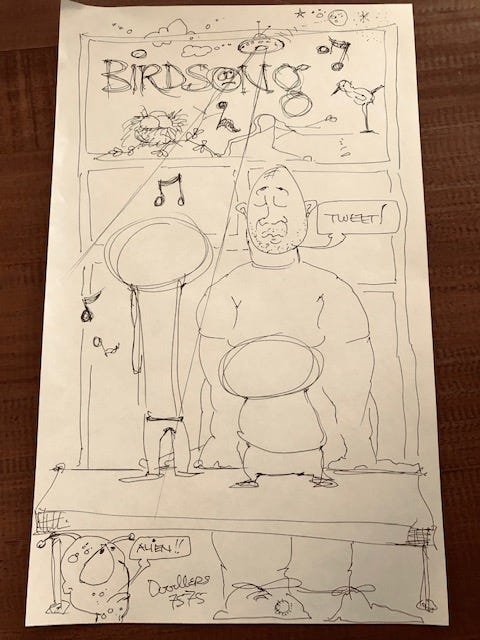
The mystery man’s actual drawing from class that day.
I know I’m tall, but I didn’t think I looked as big as he made me in the drawing. I look super huge!
He didn’t put his name on it, so I told him an artist has to sign their work before giving it to someone. It looks like his goal was to stay anonymous because he only signed it as Doodlers 7575. Maybe he somehow knew he’d make an impression on me, and I’d share this story.
When he was ready to leave, he walked towards the door and shouted an enthusiastic farewell.
"Hey, Birdsong. Keep TWEETING!"
I smiled and gave him a nod. My cartooning workshop for teenagers without any teenagers turned out alright.
Definitely, one to remember.

Even though I was having fun sharing about this unique class experience, I wanted to make sure to thank all the librarians and schools who’ve invited me to teach cartooning to their students and communities.
It’s one of my favorite things I get to do, and I’m blessed to have people who believe in my work and the power of visual storytelling.
This article originally ran in my Substack email newsletter, A New Creative Life.
You can join us by CLICKING HERE.

My caricature of artist Jean-michel Basquiat.
If you love something, let it go.
You’ve heard the saying. It doesn’t have to be forever, though especially when it’s a hobby or skill you love dearly.
I’ve been drawing all my life (at least since I was three years old), and it’s a skill I’ve worked hard to develop. Unfortunately, I still feel I’m not good enough compared to other talented artists I see online.
I feel like giving up.
I’m forty-seven, and everything I’ve worked hard for in art hasn’t gone as far as I thougth it would career wise. Making comics, drawing a comic strip syndicated online for seven years, and even freelance illustrating have only taken me so far.
I know I should stop, but I can’t.
Actually, that’s not totally true. I’ve met people who were smart enough to try making art or cartooning a career and then let it go after years of letdowns. They moved into something else more profitable and never looked back.
Being one of those people is so hard for me. Is it because I’m stupid?
I want to think it’s because I still enjoy making art. The consistent work you have to put in practicing techniques feels good when you see yourself improve.
The whole “Journey is more enjoyable than the destination” thing should be what we focus on more than money.
But what if you don’t care about creating your art anymore?
Giving up feels good. Making your passion less important in your life can relieve creative stress and expectations. There’s beauty in letting it all go.
If, after a few months, or maybe even years, you feel the pull to create again, maybe your love of the art is more a part of you than you realize.
You can always start it up again and slowly and gently add more time into your schedule for creation.
There might be times in your life when it’s harder to make your art. Like when your are a parent of a young child or you’re adjusting to moving to a new city.
When I lived in Japan for two years, I barely drew anything. I didn’t open up a sketchbook, and I rarely drew any comics. Do you know what I did do, though? I learned to speak Japanese — which takes a lot of time and effort, let me tell you. I dated and met my wife. Spending time with someone special takes effort and dedication. Giving time to explore a new country, culture, and relationship was some of the best times I’ve spent in my life.
And I wasn’t drawing or writing. I was too busy living.
Towards the end of the second year, I started writing the script for my graphic novel, Tales of Tritoria: Youngbloods, and it was refreshing to spend some of my time in creation mode.
I didn’t start drawing pages and going all in on the production of the book until I moved back to the states. Yeah, it took me a few months to get back into the swing and stamina of drawing comics again, but the time away was worth it.
I felt refreshed and excited to produce comics again. All I needed was a break.
“What if I give up, and then my type of art becomes popular? I’ll miss opportunities?”
I doubt that.
Number one, you will have work you’ve done in the past you can pull out and sell or share. Number two, timing is something you can’t predict. The right time period in your life, combined with trends in the market, could be in your favor.
You never know. That’s why focusing on doing something you enjoy is the key.
The International Society of Caricature Artists (ISCA) holds a challenge in January called Caricature Resolution with a list of names of famous people each day you can choose to draw from.
Today’s person, for example, is 1980s Neo-expressionism artist Jean-Michel Basquiat.
It took me several tries to get closer to his likeness. At first, I tried different head shapes and placement of the eyes and mouth. You get the sense of him, but in my opinion, they didn’t have his likeness.

A lot of times with caricatures, you have to try different combinations until you get it right.

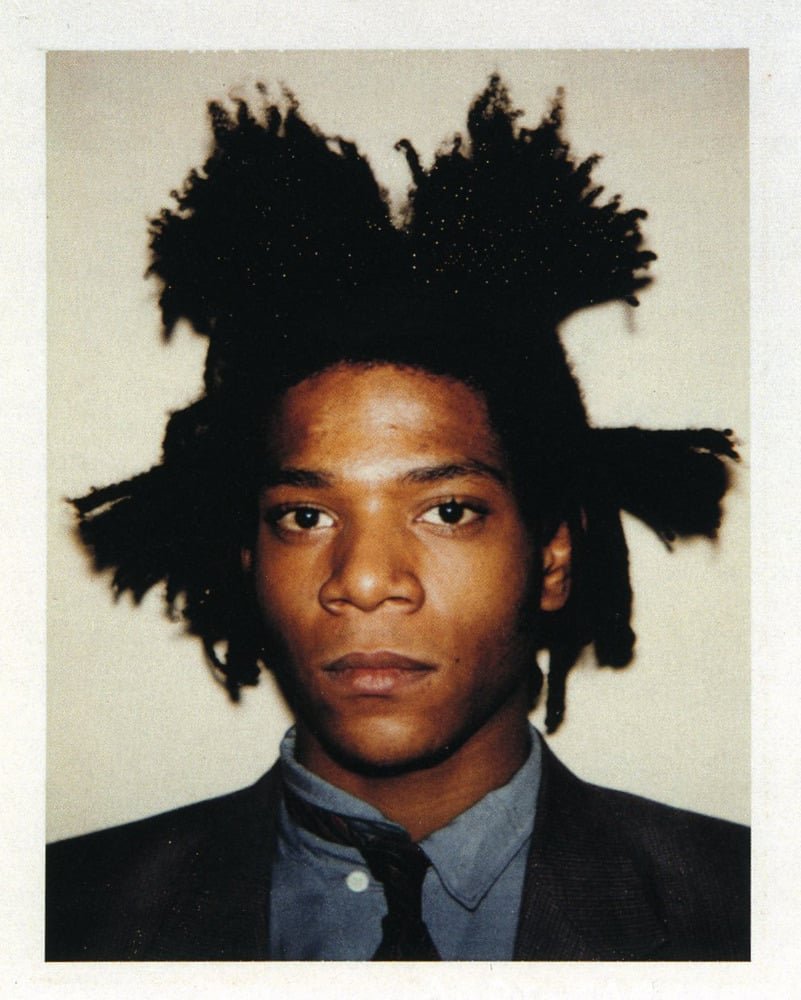
THe real basquiat for comparison.
I’m still working on getting better at drawing the likeness of celebrities, and it’s even harder than you might think. I’ve studied books, my favorite being Tom Richmond’s The Mad Art of Caricature, and watched several videos on YouTube to brush up on my skills.
Twenty years ago, I lived in Orlando, FL, and worked as a caricature artist for a small company set up in hotels and special events. All of this while starting to teach elementary school Art during the week.
I was just okay at it. You have to move fast and draw people in three to five minutes, then, I used watercolor to finish them off, and it was truly a challenge.
Sometimes people like how you draw them, and sometimes they don’t.
You grow a thick skin, but mine didn’t thicken up enough. I got tired of the demands of live caricatures and gave up after two years.
I wish I had continued. My drawing skills would have grown so fast, and who knows where it might have taken me. I never worked in Disney or Universal Studios theme parks, but that would have been the ultimate challenge.
My eyes were on making comics and publishing. Funny enough, most of the freelance work I get now comes from caricature illustration.
I’m looking to do more practice work in 2023 for art that generates more income for me.
Caricature is that art form. Why fight it?
I’ll keep practicing regularly.
Don’t say you’ll give up forever.
Making a living solely from art is extremely difficult. If you tried it and you got burnt out, take a break. Try art directing or going into a completely different field. You can always create art in your free time when you want to get back into it.
There may come a time in life when opportunities open up again for you to get paid, and you can jump back in with both feet.
There’s nothing wrong with seeing your art as a life long pursuit. You can create until you die, so why rush things?
I’m doing everything possible to keep the caricature practice light and fun. Improving is definitely a goal, but I don’t have to be pro level anytime soon.
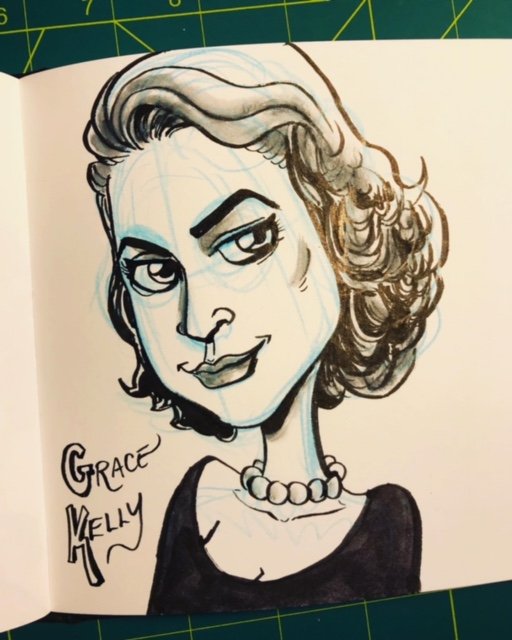

The real actor grace kelly.


the real malcolm x.
Who knows, in time, I might try getting back into live caricatures again. The thought of drawing people in person with everyone watching seems scary as hell right now. But I’ll go with the thought.
At some point in the future, it might be nice to have this skill to have fun and make money when I can.
If you’re tired and run down from not getting where you’d like with your art, take a break and give yourself time to see it in a different light.
Your passion will be waiting with open arms when you’re ready to return.
If you like my artistic outlook on life, consider subscribing to my newsletter, A New Creative Life, by clicking here.
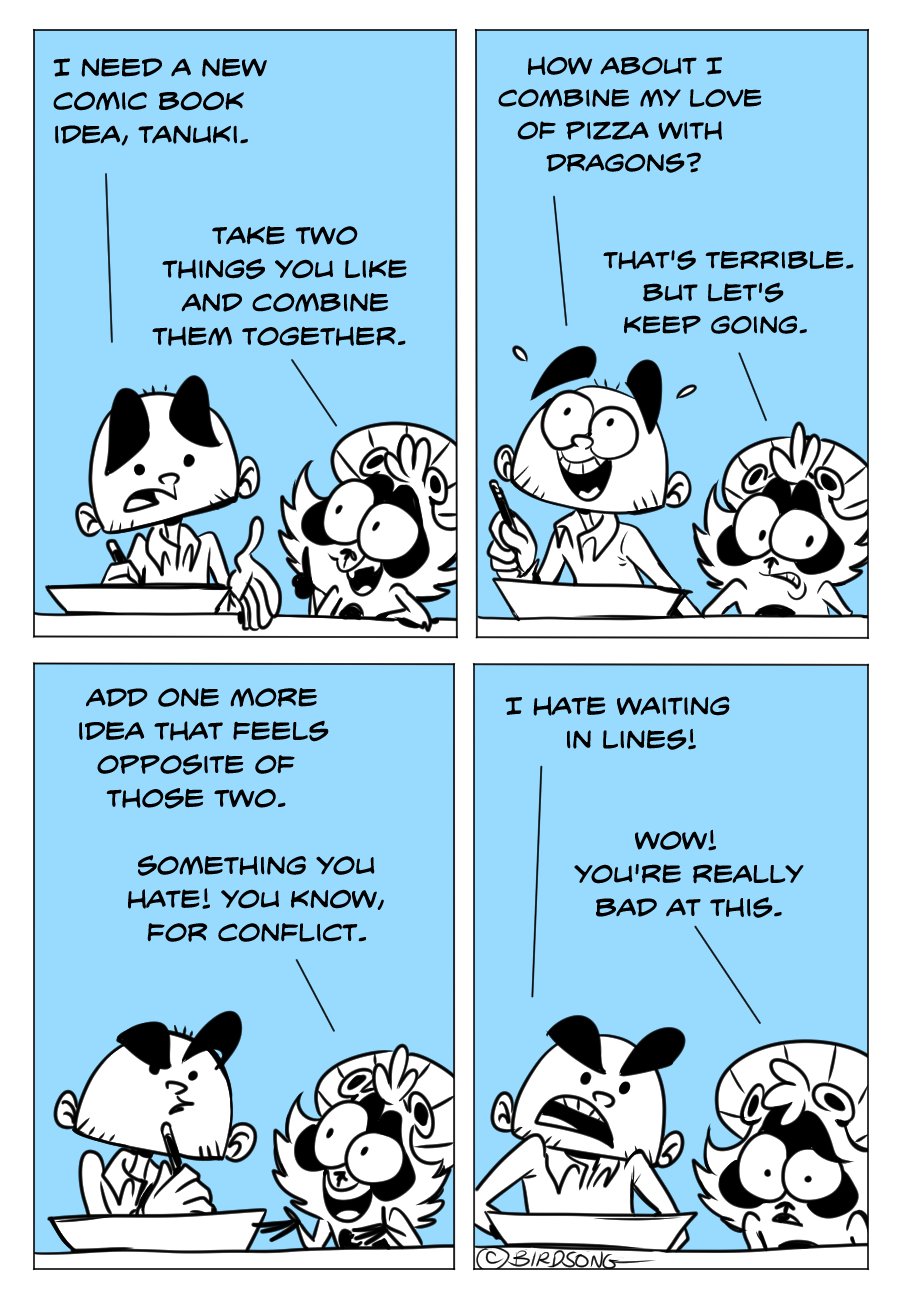
New ideas can be fun, but that doesn’t mean they’re good. © Khalid Birdsong
Mastering getting creative work done is one thing, but what happens if you don’t even know where to start?
Coming up with new ideas can be challenging.
Most people don’t have a magical Japanese Tanuki raccoon by their side to help them brainstorm. Fear not. You can always find inspiration in the world around you, the books you read, the shows you watch, and even in discussing current events with friends. When you expect to be inspired, you’ll look for exciting themes and discover ideas around you.
Okay, maybe it’s not that easy. Here are a couple of techniques I use to get inspired.
Free association can be a fun way to spill everything in your head and make connections by writing words and sketching them out in your notes.
Free association in psychology refers to a process of discovering your genuine thoughts, memories, and feelings by freely sharing all the seemingly random thoughts that pass through your mind. Usually, you are given a prompt like a word or image without context then, you say what it makes you think of. The person leading the exercise tries to create links between the prompt and your response to learn about how your brain makes connections between ideas.
Sigmund Freud was the first pioneer of the psychoanalysis technique of free association. Freud worked on developing this technique further between 1892 and 1898. This new method became a cornerstone of psychoanalytic therapy. Freud based free association on the theory of psychic determinism that informed all his work.
My way of doing this involves sitting down at my drafting table, staring at the wall, and writing down whatever comes into my head—even if it’s unrelated. For a project where I already have characters, like my Fried Chicken and Sushi comic strip, I might have one character in mind, like J, and throw out words that come to me when I think of him.
Some people say it’s crazy, but I also like asking my characters what they want to do next. I’ll often start sketching them in various poses, doing different things like cooking, playing sports, or dancing. Eventually, they answer me, and new ideas for strips emerge, sometimes quickly, after a lot of random writing and drawing.
If you’re trying to write a new story idea from scratch, you could pick a word for something you’re interested in, like football. Write down all the words that come to your mind to describe the game of football and what it means to you.
Can you create a character that wants to play football but can’t, or they only focus on becoming the best player in the world and neglects other essential parts of life?
Like Tanuki stated in the comic above, combining random ideas is fun, but a story is only interesting as long as there’s conflict.
This leads me to my next point.
Add opposites for conflict and contrast.
Anywhere you can put a character with an opposite personality to another, something that feels opposed to everything in the world you create, or an opposing view to the points in an article you write is compelling and will create even more ideas.
I’m still working on getting better at this, but whenever I’m stuck on an idea, whether writing or drawing, I go back to opposites.
Take two things you’re interested in and add something opposite.
Why? Putting two things together is easy but doesn’t make a story. Adding an opposite element to your idea gives natural conflict and possibilities to electrify your new project.

I made this comic by using the brainstorming technique with Tanuki above. © Khalid Birdsong
For example, say you’re interested in writing a fantasy short story. You think firefighters are incredible, and you love magic. Firefighters put out fires. The opposite could be a firefighter who starts fires. Or one who can start fires with magic. Is he doing it to give firefighters something to do? Is he crazy? Does he want to watch the world burn? In what kind of world are they living?
You see, just these three elements have me exploring questions and figuring out a world. Coming up with ideas isn’t as difficult as you might think. I bet you can create impressive new concepts with the above methods. The challenge is deciding which ideas are the best for you to take seriously and then start working on them regularly.
Choosing ideas to commit to long-term is a challenge we can discuss in a future post.
Stay tuned.
This post is from my weekly newsletter. I only share some of them on this website. Subscribe to A New Creative Life on Substack right here.

Photo by Kaizen Nguyễn on Unsplash
“I don’t need to practice [insert art skill]. This is just my personal style.”
How many times have I heard that from my art students? Way too many times.
If you want to get good, you have to learn to love practicing the fundamental skills of your craft when you’re young. Whether that’s in visual art, music, sports, or, yes, even writing.
It doesn’t get easier with time.
Getting good means knowing what good means. And that takes experience.
You learn by growing through repetitive practice in stuff you, at a young age, can’t see as important right now. Passing your lack of experience off as a style trait is lazy and misguided.
When you’re in school and even into your twenties, you have more energy than you know what to do with. Why make excuses for putting in the work as a creative? I bet it’s because you don’t have a coach riding your a$$ every day to write for two hours, or practice drawing portraits.
You can bet athletes hire or must attend a certain number of practices each week to stay in shape and keep their sporty skills in tip-top condition. I also bet there’s no way they would practice that much without someone holding them accountable.
But what if you can’t hire an art or writing coach? You’ve got to be the one who motivates yourself to keep going no matter how old you are.
Once you get decent at the basics, we can talk about flipping them on their head and claiming you can practice less because it’s your style. At least, that’s what I say when teaching art to middle school students. They want it to be easy right now, and it doesn’t work like that, unfortunately.
You may even be older and know how important it is to practice but still can’t get yourself to work on the boring stuff you know will grow your skills.
One thing young people don’t understand is how heavy responsibilities, like raising children, and dealing with surprise health issues, not to mention being just plain tired, make it so much harder to put in time practicing skills as you age.
No worries. All it takes is a mindset shift and a little creativity. Treat it like you’re young—fresh-faced and open to discovering more of how basic skills can improve your work.
You don’t have to love practicing the fundamentals, but you have to work on them regularly to improve.
Here’s what I tell young creatives that can also help my over-forty crowd, who need help consistently doing the things to improve their work.
Creating your art, drawing or writing should be something you enjoy no matter what, right? I’ll give you a hardy WRONG on that one! Yes, making whatever you feel like when you’re in the mood is enjoyable, but if you want to improve, you have to work even when you’re not feeling it.
Gamify your practice times to incentivize learning the boring stuff that makes you cringe. Use your creativity to make learning the basics fun, and it will be easier to want to sit down and get to work.
Let’s say you need to improve your skills in drawing hands, and what artist doesn’t? You sit down and challenge yourself to draw five hand gestures in your sketchbook in twenty minutes. Set a timer and see if you can beat it.

Figure drawing practice within thirty minutes.
Even if you’re practicing playing scales on an instrument—not the most fun activity but important—use a similar method. How many can you do in a limited time? Can you play them in several different rhythms like a song?
Becoming a better writer takes, well, writing often. Challenge yourself to see how many days a week you can write for a specific amount of time. Try one hour a day at the same time of day. Or, give yourself a word count, like 500 words each day, mark a calendar when you complete them, and on Sunday, see if you’ve won.
The act of spicing up your fundamentals will help make sitting down to do them more fun. Unfortunately, gamifying is not enough. Naturally, we all want something when we win.
When you reach your gamified goal, reward yourself with a treat — whatever that is for you. I love eating chocolate chip cookies. Sweet treats are a solid motivator for me, and I feel like I truly won an award when I get a treat afterward.
The other day, it was hard for me to focus on writing. So, I got some of those Mini Chips Ahoy cookies as motivators. They’re small so I could eat one after ten minutes of writing. Chewing on it with a smile as I write more, then after ten minutes put another in my mouth. Writing and eating treats as I go.
Not great for my waistline, I know, but I got through finishing an article. And drank a big glass of almond milk after.
You may decide you can’t watch your favorite TV show until you’ve drawn something for an hour or two. Pick the things you really do not feel like practicing, and add your best reward treat to completing them successfully.
I enjoy knowing I can draw whatever I want if I put in a certain amount of time on fundamentals. That could mean drawing three figure drawings, then a funny cartoon character.
The harder and more boring the skill, the better the reward. You’ll be getting fundamental practice easier and more often.
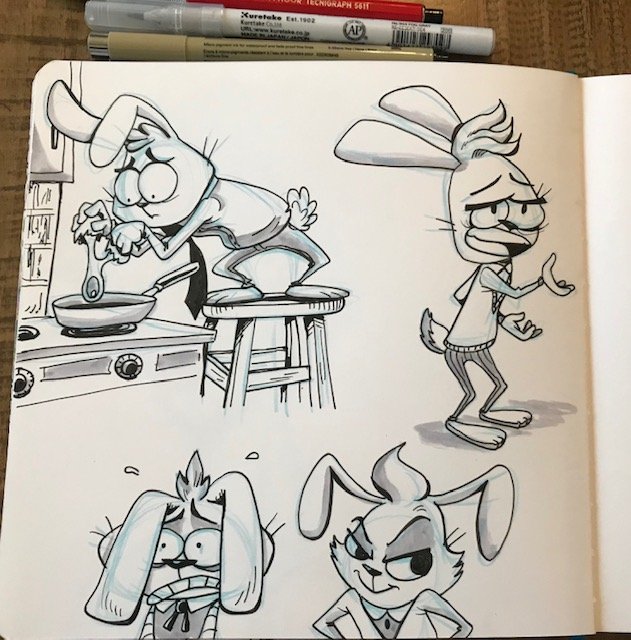
Drawing bunnies is a lot of fun after figure drawing practice.
If you’re dedicated to your chosen art form, you must learn to work with the difficult and boring parts as well as what’s enjoyable. They do go hand in hand. Even if you’re doing it mainly for fun, you’ll want to get better, telling yourself improvement doesn’t matter is a waste of time.
When you get up to go to work or school, you have to mentally prepare for the day. Why? Because it’s important. You know there will be a mix of great and not-so-great, but you take it on as a part of the experience. Do the same with your art and creative work.
Know it will be hard at times, especially when you’ve got family or health challenges, but the hard stuff makes you better and pushes you ahead. If it feels too easy, too fun, you’re probably not growing. Look for the obstacles. Find ways to work on the difficult parts because you know you need it to improve.
Doing this sort of mind shift, especially when you’re young, will help you make it a habit you continue into older age. You set a precedent that growing as a creative person takes doing the parts you enjoy and the parts that help you grow.
Trying to get yourself to do what you know you must when you’re older is harder. You become more set in your ways, and life responsibilities make it easier for you to make excuses not to create. When you have a mindset of creating regularly set in your brain, getting started, even if times are tough, is easier.
When you seek out creative challenges, find fun ways to work on them regularly, and reward your accomplishments, the boring stuff won’t be boring anymore.
Want more? If you’re struggling with doing original work, click here to join my (free) email list, and through comics, articles about culture, and living your truth, you can upgrade your mindset and share your art with the world.
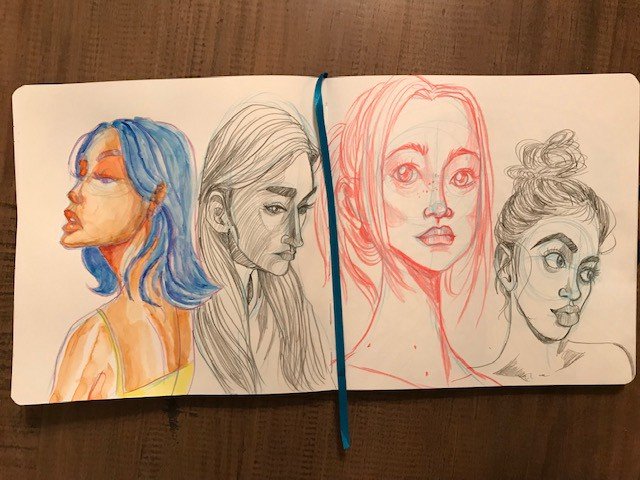
All illustrations by the author.
Do you have fun practicing the art you love consistently?
Scheduling time daily to sit down and write, draw, or even paint helps you turn it into a regular habit. Doing what you love whenever you feel like it doesn’t.
Even though I know to make it into a routine first, so my mind and body expect to create every day, I don’t always follow that advice. I’m fully aware if your goal is to improve at playing the piano, you know regular blocks of time tickling the ivory is how to grow as a musician.
If you’re trying to draw more, let this article be the reminder you need to get back on the horse.
How can you get excited about getting started, though? If you’re an artist, growing your drawing skills takes work. You know, focusing on the fundamentals, like figure drawing, anatomy, and portraiture, is essential, but maybe not all that fun.
I hear you. As a cartoonist myself, drawing funny faces and cute characters was what I was all about.
Who has time for drawing a bunch of realistic faces?
I had to accept; I most certainly should make time for it if I wanted my art to grow. The dream of filling up sketchbooks with beautiful examples of my artistic explorations has always been a dream, one I never thought I’d reach.
Taking an online class for portrait drawing via Domestika helped jolt me into committing to growing through sketchbook drawing, and I’d like to share some of what I learned with you.

You can choose all kinds of sketchbooks—large-sized ones, small enough to fit in your pocket. The ring-bound ones drive me nuts because rings on the side get in the way of my hand while drawing. Even turning the book to the side doesn’t feel right.
Everything got better when I discovered hardback, book-like sketchbooks. You can open them and lay them flat to draw across two pages or focus on one. I always feel more like a true artist when I pick it up because it looks like an actual book.
Staying on top of contributing drawings to your sketchbook is easier if you set a straightforward goal. Commit to filling every page.
Only show others what you choose or want to share, just because you feel it worked. You don’t have to take photos of your drawings or even show your work to anyone. Try and fail privately, then move to the next page.
Hardback sketchbooks are easier to collect and put on a bookshelf when you’ve completed them. They look handsome. Write a title on the spine with the year and date for your collection if you want. You can look back to see how you’ve grown over the years.
I like how you feel accomplished with a hard sketchbook instead of a soft or ringed one. You get the feeling you’re making something that will last. It’s sturdy and heavy. Like your dedication to art, it’s not easily bent or manipulated.
Picking a few areas to focus on improving, like facial expressions or body poses, can help you know how to begin. Saying you will fill one page up with different people you find from photos on Pinterest will help keep you motivated.
The next page in your book may revolve around drawing ten different hands or making a point to get away from humans and go outside to draw a landscape or urban setting.
It can be fun to get back to basics, then throw it all together. Maybe you decide to combine a mix of everything you’re studying on one page to see how you can compose it all within a small space.
Look honestly at your art. One thing I had to accept is drawing portraits from photos, especially of women, is difficult for me. I need to improve and overcome my fear of drawing attractive women, especially. I can make cute cartoony women just fine, but not beautiful realistic-looking women. Could I do it by using photo references?
Challenge accepted!
Having a hill to get over or a goal to strive for in your sketchbook will help motivate you just enough to start drawing and want to draw more. The joy of seeing what you’ve completed on each page will keep you excited about moving forward.

Why only use pencils and the occasional black pen? Drawing with colored pencils gives life to the page and catches the eye. Painting in the sketchbook with mini watercolors also helps add energy and interest.
You can use a gray brush pen for shadows and Gelly Roll pens for white highlights where needed. When I thumb through my sketchbook, I smile at the color variety and pay more attention to what I created.
Asking questions like, “Did this drawing work well?” “What can I do to draw a nose better?” The color is hard to miss, and my growth areas stand out more.
The softness of colored pencils feels nice while drawing, and it surprised me. I like to use a non-photo blue pencil first when sketching heads to rough out the head shape and eye lines, then add in features starting with the eyes and nose.
Suppose you want the easiest way to begin drawing a face. Starting with the left eye, then the nose, and over to the right eye works well. Down to the mouth or up to the eyebrows next is a good order. Try this out and find what direction works best for you.
The smoothness of colored pencil lines makes for a buttery drawing experience. Of course, the rich color will create a pleasant feeling on the page you’ll enjoy taking in as you look back on your growth.
In conclusion, I want you to know I understand it can be challenging to find time to draw. Let go of needing hours to work on the pages in your sketchbook. Even fifteen minutes at a time will do fine.
Opening up your sketchbook first thing in the morning, looking at a reference photo online, and drawing one portrait, will send a feeling of satisfaction that will last all day.
You drew something. Even one thing is better than nothing.
When you have a day with more time, by all means, draw more. Don’t get hung up on how long. Focus on your accomplishment. You added to your sketchbook, and you’re one step closer to filling it up.
Your art skills are improving.
Take a small sketchbook with you in your bag or back pocket. Sketch on the train, at the park, or in a cafe, even if it’s only for five minutes. You did it.
When you set the intention to draw regularly, use a sketchbook that feels comfortable, and add color and variety, watch how your drawings explode off the page.
Then, make sure to come back and let me know how it’s going.
Happy drawing!
Want more? If you’re struggling with doing original work, click here to join my (free) email list, and through comics, articles about culture, and living your truth, you can upgrade your mindset and share your art with the world.

Illustrated by the author.
Being a success is overrated.
Why worry about making yourself better when the world is slowly spiraling down the toilet bowl?
Let's get real here, people.
Thinking positively does little to help your attitude anyway, and you just end up feeling like a fake. Facing reality and putting yourself down can work wonders. Take it from me, a generally positive person, at least that's what all my friends call me—I'm ready for a change.
These last few years, I survived a pandemic, watching good people die in droves even after being careful not to spend time in crowds but still end up catching covid. Wearing masks and washing hands only to still, that's right, see more people catch covid. Other self-proclaimed good folks believe they don't even need a vaccine, and it's all a hoax. They seem fine with themselves.
Meanwhile, I lose my job and have to learn to survive and find a new one while everyone else is fleeing theirs. Should I try to be happy? Make it all the better by telling myself positive mantras?
If someone can decide what life means to them and choose how to live it the way they want, even if it's ridiculous, I've opted that thinking positively is getting thrown out the window.
Here's a mindset shift that defies what self-help gurus preach, so we can start demotivating ourselves and get honest about our situations. It's time you gain power from negative self-criticism.
Criticizing yourself and your appearance after waking up in the morning, looking at your sad reflection staring back, is the new motivation for success. Dominate your mind with negative talk about how you need to lose weight and exercise more.
I bet your hair looks awful. Isn't it time for a new hairdo?
Yeah, your job sucks. Who cares. What are you going to do about it? Nothing. I thought so.
Doesn't this feel good?
Destructive self-talk sculpts an image of yourself that's hard to break unless you recognize you're doing it in the first place. Embrace this downer version of you and let the Eeyore-like side shine.
What? Is all this negativity silly to you? After smelling all your garbage, you should want to clean it up.
The more you fan a flame, the more it burns. It's time to grow yours into a roaring fire with negative self-talk. How bad can you make yourself feel?
Dare yourself to try. How many crappy details about your life and failures can you drum up? Life ain't always great, so stop pretending.
Give it all you got, and feel that fire rage inside. The worse you feel, the better.
You might get so enraged that you get completely sick and tired of being sick and tired. So what?
Why don't you do something about it? Oh, you're too lazy, huh?
If only you cared enough to think of times where you made the right choices and succeeded. Accept that some things in life work out, and others don't.
Feeling bad about yourself can help make you feel good.
The other day I cursed at myself for making a wrong turn and having to re-route the directions to an appointment—one I was already late for anyway. I could have been kind and talked to my brain about how everything will be fine and work out well in the end.
But it didn't. Me being late made everything worse and upset people I care about. Maybe next time I have a meaningful engagement, I should leave super early because I suck at finding new places.
Making sure to step outside yourself and see the bad can help you know what to improve. You shouldn't hide behind positivity if you want to make real change.
You have to be unkind to yourself to know where to grow and get so upset you actually do something instead of just talking.
You have triggers that make you feel down on yourself or give up, and you might as well discover them so you know when you're spanking yourself. When we feel at our lowest, we are often about to make a breakthrough.
If you can tell when you're at rock bottom, you can be open for the moment of clarity that helps you see where to go next. Giving yourself a chance to notice what pulls you down can help you know how to climb back up. Or, better yet, how not to spiral down in the future.
Times are tough in the world right now, and we need to be tougher. You can't always fix everything by just thinking positively.
You've seen those old black and white photos of families from a hundred years ago. They weren't smiling, and they were surviving.
They didn't finish a day on the farm, working out in the hot sun, smiling, and telling themselves how happy they were. Looking in the mirror, telling themselves life can be easy and fun when life was hard. Our ancestors had very few options.
It's much easier now, but we act like it should be a breeze.
Life is still challenging, no matter how nicer our living conditions have become—facing negativity and letting it run all over you is how to understand what gets you down and leads to change.
Unless you suffer from chronic depression, you might want to see a doctor and get on medication if that's the case.
The rest of us can learn to live with our negativity and practice some grit.
Cheers to the new you.
Want more? If you’re struggling with making authentic work, click here to join my (free) email list, and through comics, articles about culture, and living your truth, you can discover how to upgrade your mindset and share your creative writing and art with the world.

I was afraid to post this comic strip, but I knew it had to be said. America is a dangerous and downright scary place for Black people. Even though no area you live in is perfect, there are some countries and even cities where you can feel more like yourself.
I found Osaka, Japan, to be one of those places for me. If you travel enough, you’ll find yours. Is it acceptable, however, for me to talk about racism in a cute family comic strip intended to make you laugh?
I lived in Japan for two years teaching English, but now I live in the U.S. and visit Japan every year. Making a point to soak up the peace and experience the culture. Don’t get me wrong, there are aspects I love about my home country.
Let’s be real, though, it’s tough on black folks in the states. The fear of racism and police brutality makes everyday life feel scary when you’re doing just about anything.
I think it’s important to address racism and perception in comic form and get people thinking. Even if the humor just makes you uncomfortable. As a Black man, my work wouldn’t feel authentic without it. The character, J, in this strip, is communicating how I feel while living in or visiting Japan as a Black man.
Free to be me.
Even though it’s told from a child’s point of view in this strip, the sentiment comes from my raw emotions and frustrations. But I was nervous about posting it and almost didn’t. You want to know why?
I was concerned about hurting white people’s feelings.
The comics and articles I create are not made to upset anyone but give my perspective, as a Black man, on the world and how I see things. In the past, after posting a series of lighthearted comics and then suddenly putting a strip out stating America isn’t a perfect union, mainly white people get upset.
It’s like they can’t handle the truth. Could it be certain white folks think I don’t have a right to express my frustrations and concerns over how people of color are treated in America? Like I can’t talk about my people and our struggles through an art form I love. Maybe, I should just stick to the silly jokes.
I know, free speech works both ways. If I can say what I feel in my work, people should have the freedom to comment on it. Yes, but when you do, please pay attention to your privilege.
Are you trying to tell me I’m wrong for how I feel? If you think my comics are now “complete garbage” from one comic strip and you can’t read them anymore. Why? Are there deeply held beliefs that need changing, lurking deep inside you? When you read through my archives, plenty of previous Fried Chicken and Sushi comics tackled racism and prejudice concerning people who are different.
White people get to choose what they believe about racism even though they haven’t experienced it directly. Being a part of the majority, they get to say ridiculous things in the comments of my comics. Like, “This is racist.” or an insult dressed up as a compliment, “I don’t see color” (please see my color, I happen to love it) or “Racism doesn’t exist in America anymore.” Does anyone really believe that?
Black people have to live with and take the blows associated with racism daily. Just because you aren’t seeing racist acts in your neighborhood or workplace, doesn’t mean they don’t exist.
I like showing that we all have other choices of places to live in the world. The truth is, it ain’t easy traveling abroad either. Finding work that pays enough to live on, and securing a way to stay there for many years — like getting your visa sponsored by an employer or becoming a permanent resident. But it is possible if you want it bad enough.
Notably, in Asia. You will deal with prejudice and ignorance about your race, especially if you’re Black. Still, the lack of fear and hate over your skin color brought on by systemic racism makes up for it.
The freedom that comes from living in a country like Japan — not built on the backs of free labor from African slaves — feels exhilarating. People see you as a person, a very different person than them for sure, but not someone to fear as a threat to their livelihood.
I know all of this and feel strongly about the benefits of living in Asia. I’m choosing, however, to work in the U.S. right now. I find it easier to get work that pays well, and I like engaging with a diverse group of people. When I need a break, the money I put away for travel helps me escape to Japan, the Philippines, or Hong Kong to get a different experience.
Where I can be just a foreigner.
Returning to my home country from trips abroad can be a tough re-entry. I get hit with the reality that most American citizens still do not fully see or understand. You hear the words “Black Lives Matter” but Black people are still treated poorly. This “BLM” phrase doesn’t mean all other lives have it easy. It means Black lives, particularly in America, need to matter now more than ever. Our house is the one on fire in the neighborhood. It’s the one that needs the most attention right now. Let the fire department put out the flames. Should they spray all the other homes on the street with water, just to be fair?
I think things are getting better. The above FC&S comic received mostly supportive comments and started conversations on GoComics around the benefits of travel and having an open mind.
It was a risk I was glad I took. Please become comfortable listening to what Black people are saying about their experiences, hopes, and challenges when expressed through their writing and creative work.
Give us a chance to matter.
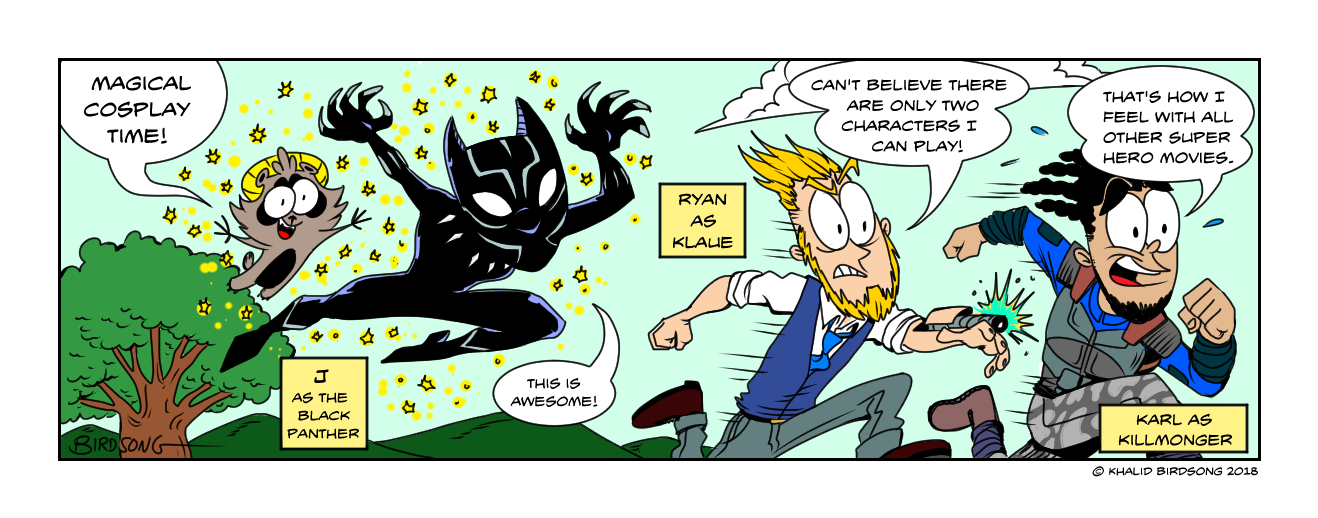
When I first started drawing Little Fried Chicken and Sushi comic strips my main goal was to make them timeless by not adding any current events or obvious pop-culture references.
After watching the Black Panther movie, I changed that goal. Breaking my rules looked scary. I couldn’t stop thinking about if I draw strips based on a popular movie, it will date the strip when I eventually collect them into books.
I had to do it!
Black Panther was spectacular in so many ways film wise and as a part of not only black culture but American culture as a whole. There was no way I wasn’t going to make strips about the film!
Of course, it also made about a bajillion dollars at the box office. Not bad for a movie about powerful African characters. There was definitely an audience for this.
First, I thought about how I felt right after seeing it.
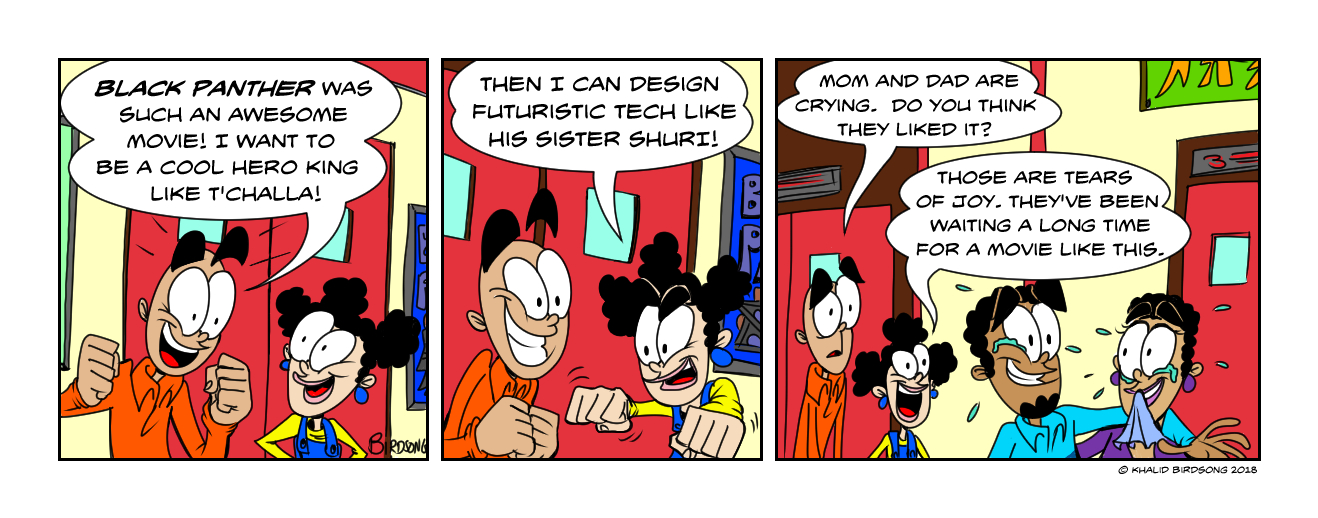
The feeling of creating the boy characters J, Ryan and Karl as T’Challa, Klaue and Killmonger in the above strip was enormously fulfilling. This was my first time creating strips that directly related to real movie characters. I couldn’t believe how much fun I was having!
It took some research and a great deal of drawing details, but I did my final of three Black Panther strips on the women. Mom as Queen Ramonda and little Kasha as Princess Shuri.

Tanuki’s magic ended up being a great way to experiment with cosplay on the main characters and try my hand at adding in current events.
My mind is more relaxed with the idea now and it’s already churning away thinking of possible gags to add in more pop-culture references in future strips.
Yes. This means the strip changes into something more timely rather than timeless, but I’m pretty sure it will be enjoyable to make and hopefully fun to read.
All the best,
Khalid

Ninja Space Bunny hangs on! Day 1 of Inktober from the prompt FAST!
Every October illustrators and cartoonists all over the world have the opportunity to participate in the daily drawing event entitled Inktober. Created by the amazing artist, Jake Parker, the main rule is to create a drawing in ink on a regular basis in the month of October. You can post something online every day or a few times a week. The point is to push yourself, try something new and grow as an artist.

Ninja Space Bunny should keep his music down. Inktober day 2- NOISY
I have been participating for the past two years and find it to be a challenge but a great way for my drawing skills to improve. This year, without having regular Fried Chicken and Sushi comics to draw, I chose to try and post something every day. I never work much with animals so each week I'll focus on a different cartoon animal and illustrate it using the prompt list Jake Parker came up with. It's great because each day there's a word to use as inspiration for drawing ideas.

"In space, carrots are hard to come by. You must collect them when you can." -Ninja Space Bunny
Inktober day 3- COLLECT
Here are all 7 of the first round of Inktober drawings done mainly with Pigma Micron pens, Sharpies and even an inexpensive Magic Drawing Pen I bought at a 100 Yen store in Japan. The theme revolves around a Ninja Space Bunny and his adventures. A silly concept but it was more fun to draw than I expected. Hope you enjoy them!
You can keep up with my Inktober drawings on Instagram where I'm friedchicksushi and also on Twitter as @khalidbirdsong.

Ninja Space Bunny should remember to eat before a spy mission! Inktober day 4- HUNGRY

Ninja Space Bunny is so tough, he cuts cake with his hands! Unfortunately, no one ever comes to his birthday parties. Inktober day 5- SAD

Ninja Space Bunny finally convinced a friend to come over to his ship to play hide and seek! Inktober day 6- HIDDEN

Some say he gave up on the life of being a Ninja Space Bunny. Others say, he was just lost.
Inktober day 7- LOST
Fried Chicken and Sushi is a Blog and humorous comic strip about living in Japan and Japanese pop-culture.
© copyright 2010 - Khalid Birdsong All Rights Reserved.